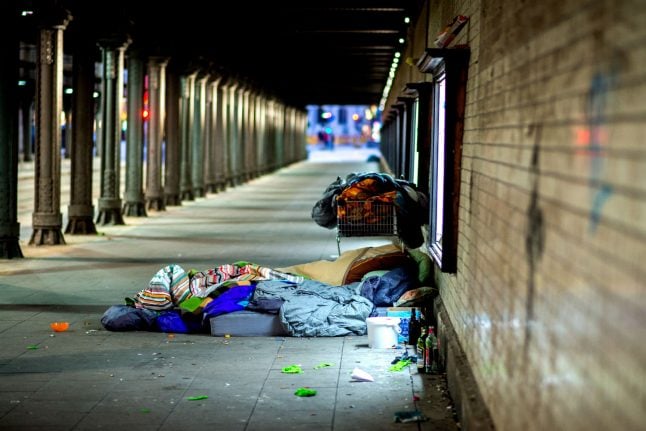About 48,000 of those people are sleeping on the streets, according to the statistics from the Federal Association of Homelessness Help (BAGW).
An additional 275,000 people were homeless due to job losses, mounting debts or personal “strokes of fate”, wrote the BAGW.
The numbers of homelessness – both in shelters and on the streets – is on the rise, they said, without yet being able to provide concrete numbers.
The increase in homelessness can be attributed largely to a lack of affordable housing, said BAGW, who proposed that Germany build more social housing units.
The number of such units has dipped by 60 percent since 1990 to 1.2 million, as the German government continues to sell its stock of units to private investors.
Housing crisis
In order to fight homelessness, BAGW’s managing director Werena Rosenke demanded that a higher proportion of socially housing be made available explicitly for homeless people.
“80,000 to 100,000 new social housing units and a further 100,000 affordable housing units are needed per year,” she wrote. In total the homelessness association believes around 200,000 affordable homes are needed each year.
According to the Institute of the German Economy (IW), 287,000 apartments were completed nationwide in 2018, and figure is unlikely to rise significantly this year. Of those, only 27,040 were subsidized homes.
However, while there remains a serious housing shortage in large cities, there is a vacancy and oversupply in smaller cities and rural areas.
SEE ALSO: How new homes are not being built where they are the most needed in Germany
A total of 342,000 new dwellings would be needed in 2019 and 2020 in order to accommodate everyone who needs a home, estimates BAGW.
Immigration on the rise
Another root cause of the rise in homelessness is the immigration spike in the past few years, both from other EU countries and in the form of refugees and asylum seekers.
Among the homeless, there are 375,000 recognized asylum seekers and refugees in special accommodation and reception centres.
Eight percent, or 22,000, of the homeless are children and young people. Most of those affected were men, with a quarter of them women.
Out of the the 48,000 people who sleep on the streets, many come from other EU countries, especially within Eastern Europe.
In larger cities like Berlin, makeshift tent camps have been set up in parks and open spaces. Their inhabitants face dangerous conditions in the winter, or relocate to U-Bahn stations.
SEE ALSO: How Berlin is struggling to deal with growing homelessness in its parks
'Offensive against homelessness'
Katrin Göring-Eckardt, leader of the Green parliamentary group, demanded rapid measures be enforced by Interior Minister Horst Seehofer (CSU) “so that the stock of social housing will increase again instead of decrease”.
The Left party leader Katja Kipping demanded an “offensive against homelessness” – which would include emergency aid in cases where rent couldn't be paid.
“The fear that the apartment will become unaffordable now burdens a large part of the population,” said Verene Bentele, president of the social advocacy organization vDK.
Among other things, a “well-functioning Mietpreisbremse (rental price brake)” is necessary, she added.
Vocabulary
Homelessness – (die) Obdachlosigkeit
Strokes of fate – Schicksalsschlägen
Estimates – (die) Schätzungen
Housing shortage – (der) Wohnungsmangel
Federal Association of Homelessness Help – Bundesarbeitsgemeinschaft Wohnungslosenhilfe
Reception centres – (die) Erstaufnahmeeinrichtung



 Please whitelist us to continue reading.
Please whitelist us to continue reading.
Member comments